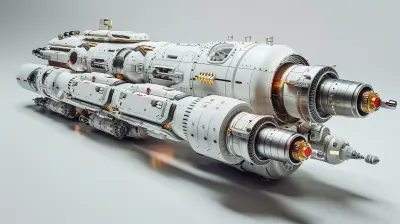14 April 2025
Augmented Reality (AR) is no longer just a fancy tech trend reserved for video games and social media filters. It has set its sights on something much grander—the cosmos! From training astronauts to assisting in complex space missions, AR is revolutionizing the way we explore space. Imagine astronauts navigating alien terrain with real-time data overlay, or engineers fixing a spacecraft using holographic instructions. Sounds like science fiction? Well, it’s quickly becoming reality!

The Role of AR in Space Exploration
Space exploration comes with unique challenges—extreme environments, communication delays, and the need for precision. That’s where AR steps in, acting like a high-tech Swiss Army knife. By overlaying digital information onto the real world, AR equips astronauts, scientists, and engineers with a more intuitive way to interact with data, tools, and surroundings.
1. AR-Powered Astronaut Training
Training astronauts is no joke. NASA and other space agencies conduct years of rigorous preparation, but traditional training methods have their limitations. Enter AR!- Hands-on Learning in Virtual Environments
Instead of relying only on manuals and simulations, astronauts can train using AR headsets that project intricate spacecraft models, mission procedures, and spacewalk scenarios into their field of view. It’s like having a personal holographic instructor guiding them every step of the way.
- Reducing Human Errors
By interacting with 3D overlays and real-time feedback, astronauts can familiarize themselves with critical tasks before even reaching space. This significantly lowers the chances of errors during crucial moments.
2. Spacecraft Maintenance and Repairs
Imagine being in deep space, and something malfunctions on the spacecraft. There’s no repair shop around the corner, and verbal instructions from Earth could take minutes to arrive. That’s where AR proves invaluable.- AR-Assisted Repairs
Engineers can wear AR headsets that display step-by-step repair instructions directly onto malfunctioning equipment. It’s like having an interactive manual floating in mid-air, guiding them in real time.
- Remote Support from Earth
Ground control can annotate a live view of the issue and send real-time visual cues to astronauts. It’s essentially a high-tech game of Pictionary, but with life-saving stakes!
3. Navigation on Other Planets
Exploring alien landscapes is no easy task. The terrain is unpredictable, the environment unforgiving, and there’s no GPS to rely on. AR helps astronauts navigate safely with:- Real-Time Data Overlays
When astronauts step onto Mars or the Moon, AR-powered helmets can display essential information—oxygen levels, surface hazards, radiation exposure—right in their line of sight. No need to fumble with instruments or manuals!
- Mapping Alien Terrain
Rovers and astronauts can use AR to create detailed 3D maps of the surface, helping them plan efficient routes and avoid treacherous obstacles. Think of it as Google Maps for outer space—minus the traffic.
4. Mission Control Operations
Back on Earth, mission control plays a crucial role in guiding space missions. AR isn’t just helping astronauts—it’s revolutionizing how space agencies operate from the ground.- Interactive Mission Planning
Instead of interpreting complex data from screens, scientists can use AR to visualize space missions in 3D, allowing for better decision-making and problem-solving.
- Enhanced Collaboration
Whether in Houston or halfway across the globe, teams can work together in shared AR environments, reviewing spacecraft designs, mission plans, and simulations as if they were physically in the same room.

AR and the Future of Space Exploration
We’re still in the early stages of integrating AR into space missions, but the possibilities are endless. Imagine:- AR-Driven Space Colonization
Future Mars settlers could use AR for building habitats, farming, and scientific research, all while receiving guidance from Earth through holographic projections.
- Tourism Beyond Earth
As commercial space travel gears up, AR could enhance the experience by providing tourists with real-time information about the cosmos—turning a trip into an interactive learning adventure.
- AI + AR for Autonomous Missions
When combined with artificial intelligence, AR could assist unmanned spacecraft in conducting scientific research, assembling structures in space, and even searching for extraterrestrial life.







Zevran McFarlin
This article compellingly highlights the transformative role of augmented reality in space exploration. It's fascinating to see how AR technology enhances our understanding of the cosmos, making complex data more accessible and engaging for researchers and enthusiasts alike.
April 23, 2025 at 8:02 PM